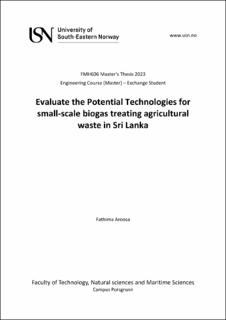| dc.description.abstract | This study explored the assessment of technologies for small-scale biogas treatment of agricultural waste in Sri Lanka. The study’s main objective is to evaluate the current small-scale anaerobic technologies. This evaluation was conducted through an extensive literature review, focusing on developing countries with conditions similar to Sri Lanka. Additionally, by integrating the simulation process using the Anaerobic Digestion Model No. 1 (ADM1), which is widely used to simulate and predict the behavior of the AD process. This model, coupled with AQUASIM 2.0 software, the study endeavored to forecast and analyze the performance of AD. The current evaluation conducted in this study suggests fixed dome, floating drum, and plug-flow bag technologies as particularly suitable for small-scale agricultural waste treatment. According to the simulation performed preliminary, the optimal performance of the AD system with a CSTR-type reactor with a volume of 8 m3, flow rate of 1.0 m3/day, and an 8-day hydraulic retention time in simulated conditions resulted in the highest methane percentage. | |
